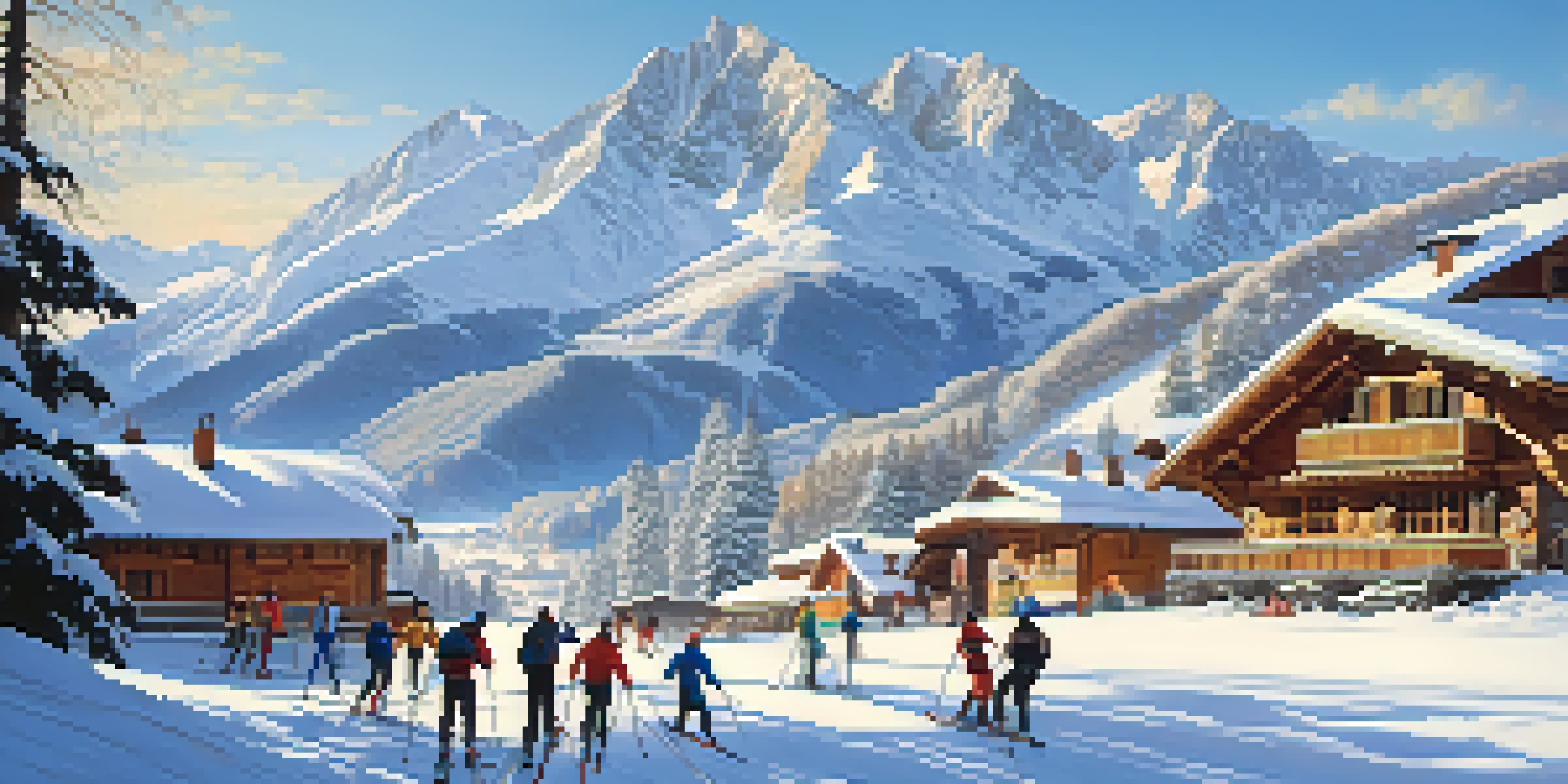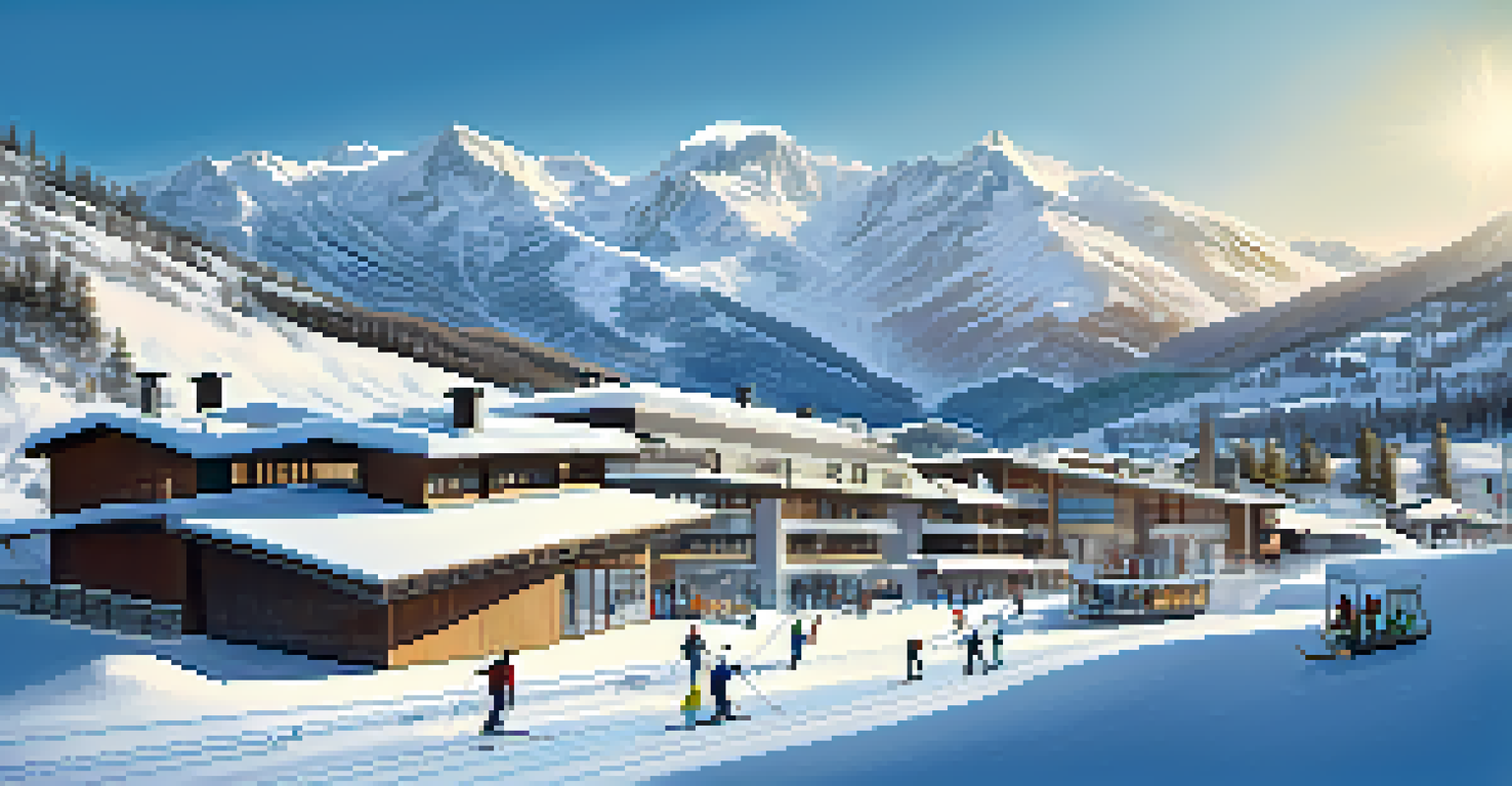The Rise of Winter Sports Tourism in Spain: An Overview

The Allure of Spain's Winter Sports Destinations
Spain might be famous for its sunny beaches, but its mountainous regions are becoming a winter sports haven. With the Pyrenees and Sierra Nevada offering breathtaking landscapes, skiers and snowboarders from around the globe are flocking to these areas. The combination of diverse terrains and excellent snow conditions makes Spain an attractive destination for winter sports enthusiasts.
Skiing is a dance, and the mountain always leads.
For instance, resorts like Baqueira Beret in the Pyrenees boast over 150 kilometers of slopes, catering to all skill levels. This variety not only draws seasoned athletes but also families looking for a fun winter getaway. The picturesque villages nearby enhance the overall experience, providing cozy accommodations and warm local cuisine.
Moreover, Spain's relatively mild winter temperatures allow for a longer skiing season compared to other European destinations. This extended timeframe means that tourists can enjoy winter sports without the extreme cold that often accompanies such activities in other regions.
Economic Impact of Winter Sports Tourism
The rise of winter sports tourism in Spain has significant economic implications for local communities. As more tourists arrive for skiing and snowboarding, the demand for services such as hotels, restaurants, and rental shops skyrockets. This influx of visitors not only boosts the economy but also creates job opportunities for locals.

For instance, the Sierra Nevada region has seen a marked increase in employment opportunities directly related to the tourism sector. From ski instructors to hospitality staff, the growth of winter sports tourism fosters a vibrant job market. This positive economic impact encourages local governments to invest in infrastructure and services that further enhance the tourist experience.
Spain's Winter Sports Boom
Spain's mountainous regions are emerging as top winter sports destinations, attracting global visitors with their diverse terrains and mild weather.
Additionally, the increased visibility of Spain as a winter sports destination contributes to a longer-term economic strategy. By diversifying its tourism offerings, Spain can reduce dependency on summer tourism, ensuring a more stable and resilient economy throughout the year.
The Role of Infrastructure Development
Infrastructure plays a pivotal role in the growth of winter sports tourism in Spain. Modern ski lifts, well-maintained slopes, and efficient transportation systems are essential for attracting visitors. Over the past few years, significant investments have been made to upgrade facilities, making the skiing experience more enjoyable and accessible.
The mountains are calling and I must go.
For example, the latest high-speed gondolas have drastically reduced wait times, allowing skiers to maximize their time on the slopes. Improved road networks also ensure that travelers can easily reach popular ski resorts, further boosting visitor numbers. Such developments not only enhance the overall experience but also position Spain as a competitive player in the European winter sports market.
Moreover, advancements in technology, such as mobile apps for real-time slope conditions and booking systems, have made planning a winter sports trip easier than ever. This seamless experience encourages more tourists to choose Spain for their winter adventures.
Diverse Activities Beyond Skiing
While skiing and snowboarding are the main attractions, winter sports tourism in Spain offers a variety of activities. Snowshoeing, cross-country skiing, and even ice climbing are gaining popularity, appealing to a broader audience. This diversity allows winter sports enthusiasts to explore the stunning natural landscapes in different ways.
For instance, families with young children may prefer snowshoeing, which is less strenuous and allows them to enjoy the scenery at a leisurely pace. Similarly, adventure seekers can challenge themselves with ice climbing in spectacular locations like the Pyrenees. These alternative activities not only attract more visitors but also promote a deeper appreciation of Spain's winter landscapes.
Economic Growth from Tourism
The rise in winter sports tourism significantly boosts local economies, creating job opportunities and encouraging infrastructure investments.
Additionally, many resorts host special events and festivals centered around winter sports, further enriching the experience. From snow festivals to competitions, these events create a festive atmosphere that draws both locals and tourists, fostering a sense of community and excitement.
Eco-Friendly Practices in Winter Sports Tourism
As winter sports tourism grows, so does the awareness of its environmental impact. Many ski resorts in Spain are adopting eco-friendly practices to preserve their stunning natural surroundings. This shift not only attracts environmentally conscious travelers but also promotes sustainable tourism, which is crucial for the future of these destinations.
For example, several resorts are implementing energy-efficient technologies, such as solar panels and eco-friendly snowmaking machines. These initiatives minimize the carbon footprint associated with winter sports activities. Additionally, promoting public transport options for reaching ski resorts helps reduce traffic congestion and pollution in these pristine areas.
Moreover, educational programs aimed at tourists encourage responsible behavior while enjoying winter sports. By fostering a culture of conservation, Spain's winter sports tourism can thrive without sacrificing the beauty of its landscapes, ensuring that future generations can enjoy these winter wonderlands.
Cultural Experiences in Winter Sports Regions
Winter sports tourism in Spain is not just about the slopes; it also offers rich cultural experiences. Each mountainous region has its unique traditions and customs that visitors can explore after a day on the slopes. From local cuisine to traditional festivals, these cultural elements add depth to the winter sports experience.
For instance, after a day of skiing in the Sierra Nevada, tourists can indulge in delicious tapas and warm up with a glass of mulled wine at a local tavern. Engaging with the local culture provides a well-rounded experience, allowing visitors to appreciate the region's history and lifestyle beyond just the winter sports.
Embracing Sustainability
Ski resorts in Spain are adopting eco-friendly practices to mitigate environmental impacts, ensuring the preservation of natural landscapes for future generations.
Additionally, many resorts organize cultural events such as art exhibitions, craft markets, and music festivals, further enriching the winter sports tourism experience. These activities not only entertain but also create opportunities for interaction between tourists and locals, fostering a sense of community and shared enjoyment.
Challenges and Opportunities Ahead
Despite the booming winter sports tourism in Spain, challenges lurk on the horizon. Climate change poses a significant threat to snow reliability in the coming years, which could impact the attractiveness of ski resorts. It's essential for the industry to adapt and innovate to ensure sustainability and continued growth.
One potential solution is to diversify offerings beyond traditional winter sports. By promoting activities such as winter hiking, wellness retreats, and even cultural tourism, Spain can maintain its appeal even in less-than-ideal snow conditions. This versatility will help mitigate the risks associated with climate fluctuations.

Furthermore, collaboration between governments, local businesses, and environmental organizations can facilitate the development of sustainable practices. By working together, stakeholders can create a robust winter sports tourism framework that prioritizes both economic growth and environmental preservation.